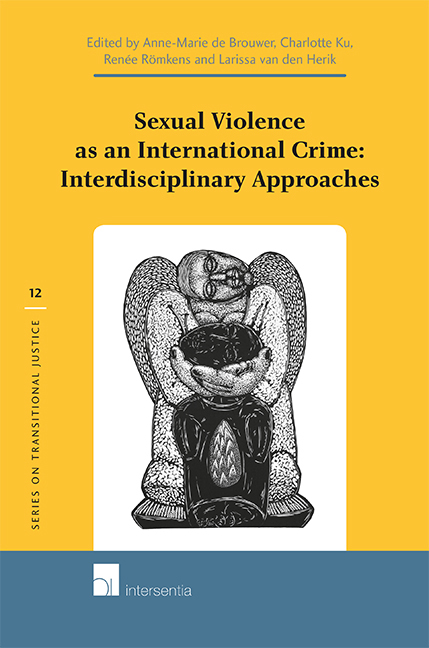Book contents
- Frontmatter
- Acknowledgements
- Foreword
- Contents
- Abbreviations
- INTRODUCTION
- PART 1 OVERVIEW OF SEVERAL MILESTONES AND CHALLENGES CONCERNING INTERNATIONAL CRIMINAL PROSECUTION OF SEXUAL VIOLENCE
- A HISTORICAL PERSPECTIVE, THE WAY FORWARD AND MILESTONES LONG OVERLOOKED
- THE INTERNATIONAL TRIBUNALS AND COURTS
- PART 2 SOCIAL, ARCHIVAL AND MEDICAL DATA COLLECTION AND ITS USE FOR THE CRIMINAL LAW PROCESS: METHODOLOGY ISSUES
- PART 3 SURVIVING SEXUAL VIOLENCE, STORY TELLING AND CREATING AWARENESS
- CONCLUDING REMARKS
- About the Contributors
Chapter 2 - Treatment of Sexual Violence in Armed Conflicts: A Historical Perspective and the Way Forward
Published online by Cambridge University Press: 16 December 2020
- Frontmatter
- Acknowledgements
- Foreword
- Contents
- Abbreviations
- INTRODUCTION
- PART 1 OVERVIEW OF SEVERAL MILESTONES AND CHALLENGES CONCERNING INTERNATIONAL CRIMINAL PROSECUTION OF SEXUAL VIOLENCE
- A HISTORICAL PERSPECTIVE, THE WAY FORWARD AND MILESTONES LONG OVERLOOKED
- THE INTERNATIONAL TRIBUNALS AND COURTS
- PART 2 SOCIAL, ARCHIVAL AND MEDICAL DATA COLLECTION AND ITS USE FOR THE CRIMINAL LAW PROCESS: METHODOLOGY ISSUES
- PART 3 SURVIVING SEXUAL VIOLENCE, STORY TELLING AND CREATING AWARENESS
- CONCLUDING REMARKS
- About the Contributors
Summary
SUMMARY
War and atrocities are intricately interlinked. Armed conflict has occurred since the existence of humankind and with it, sexual violence is rampant, committed both opportunistically and strategically. With war comes misery and destruction paralleled only perhaps by the worst natural disasters unleashed by the power of nature. Weaponry and technology have become far more sophisticated in the past century and are used in many, but by no means all, of the contemporary wars. Violence, including against civilian women and girls, not only continues, it has increased as civilians have become the primary targets of armed conflict.
Traditionally, women were regarded as legitimate spoils of war or rape as an inevitable by-product of war. Although opportunistic rape continues during the atmosphere of violence, chaos, hatred, retaliation, and the breakdown of the rule of law common in armed conflict, various forms of sexual violence are also used as strategic weapons of warfare, committed as part of a calculated strategy to terrorize, demoralize, and destroy victims, families, and communities or associated groups.
After centuries of wars within nations and between nations, it took the monstrous atrocities committed in the 1940s during World War II for the international community to finally create two international war crimes tribunals to try those most responsible for serious crimes committed during the war. Hence, when the Second World War ended, the Allied victors established the International Military Tribunal (IMT) in Nuremberg, Germany to try vanquished Nazi leaders, and the International Military Tribunal for the Far East (IMTFE) in Tokyo, Japan to prosecute senior Japanese officials. Some crimes of sexual violence were explicitly or implicitly prosecuted in these trials, although the primary focus was on prosecuting crimes against peace, considered the supreme crime.
Despite the historical significance of and legal precedent set by these groundbreaking efforts to establish individual accountability for massive crimes, impunity reigned for gender and non-gender crimes for nearly five decades afterwards in armed conflicts scattered throughout the world.
In 1993 and 1994 – nearly half a century after the Nuremberg and Tokyo trials – the United Nations Security Council created two ad hoc international war crimes tribunals to punish individuals responsible for serious violations of humanitarian law committed in the territory of the former Yugoslavia and for genocide in Rwanda.
- Type
- Chapter
- Information
- Publisher: IntersentiaPrint publication year: 2013
- 16
- Cited by



